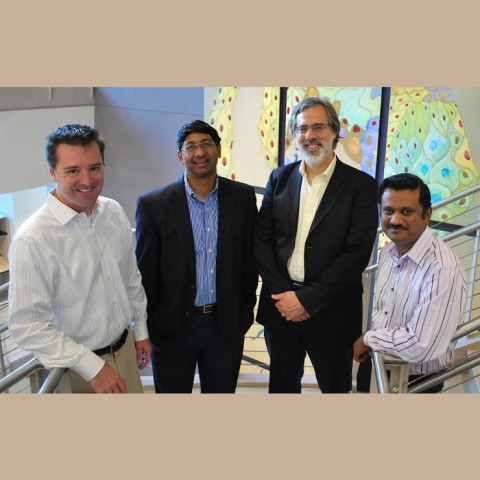
Four scientists at the Georgia Institute of Technology are among the top medical researchers in Georgia, according to the Atlanta Business Chronicle.
Four scientists at the Georgia Institute of Technology are among the top medical researchers in Georgia, according to the Atlanta Business Chronicle in a recent cover story (May 16-22 edition). But to hear them tell it, the number could easily be much higher.
“It’s a nice honor, to be recognized like this, but all of us are engaged in a number of collaborative efforts, so any successes we achieve individually represent the efforts of a broad community of our collaborators and colleagues,” says Todd McDevitt, Carol Ann and David D. Flanagan professor in the Wallace H. Coulter Department of Biomedical Engineering and also director of the Stem Cell Engineering Center. “Collectively, we’re a lot stronger than the individual pieces alone.”
McDevitt, along with Ravi Bellamkonda, Ross Ethier and Krishnendu Roy are among the 20 scientists featured in the article by Ellie Hensley, who writes, “Respected research universities like Georgia Tech and Emory University draw top talent, and a high level of collaborations between institutions like these creates a unique environment for scientists in the state.”
Indeed, partnerships with other institutions – like the one between Georgia Tech and Emory resulting in the Wallace H. Coulter Department of Biomedical Engineering – are a big reason these scientists happen to be here.
“That was very important to me. The collaborative effort is definitely something that attracted me to Georgia Tech – that, and also the opportunity to work with highly talented people who work in similar research areas,” says Roy, Carol Ann and David D. Flanagan Professor and Director of the Center for Immunoengineering at Georgia Tech, who came here from the University of Texas at Austin last summer.
Regarding the Georgia Tech-Emory collaboration, Ethier adds, “The idea of a partnership between public and private universities is certainly unusual, and a testament to people having vision and foresight.”
Ethier, the Georgia Research Alliance (GRA) Lawrence L. Gellerstedt, Jr. Eminent Scholar in Bioengineering, researches the biomechanics of cells and whole organs, targetting, among other things, glaucoma and new ways to treat the condition, which is the second most common cause of blindness. But it takes a collaborative, interdisciplinary approach, and enthusiastic support and leadership from a variety of sources, to make groundbreaking discoveries, and all of that is in place here, enough of it to have lured Ethier from the UK to Atlanta.
“The GRA provided me with the infrastructure to kick-start my research here, and that was really important,” says Ethier. “And there’s a can-do attitude here that’s so refreshing. You’re talking to folks, you ask a question and they tend to say, ‘yeah, we can figure out a way to make that happen.’”
That willingness to make things happen – and also to take risks – is one of the human (and institutional) elements that appeals most to Bellamkonda, who chairs the Wallace H. Coulter Department of Biomedical Engineering, and researches neural tissue engineering and cancer and is working to develop targeted drug delivery for brain tumor therapy.
“In my mind, we have a can-do, fearless attitude in medical research that perhaps comes from the influence of engineering thought in medicine,” he says. “In my personal case, I've realized somewhere along the way that research is not about building a career – its about making progress and having an impact. Kids and older patients who might benefit from our research don't have the luxury of time – they need the advances we are working on today. And for this reason, it is worth taking on higher risk, high reward projects to complement more incremental research. These two elements - not being afraid of failure, and the need to make progress at a different pace than the field as a whole is moving, lead to breakthroughs in my mind. And my experience is completely consistent with this.”
Atlanta and Georgia, while not yet in the same league with longtime bio centers like Boston or San Francisco, is nonetheless a powerful and growing hub of activity. The state is 12th in research funding, and Atlanta is fifth in research expenditures, according to the article in the Atlanta Business Chronicle.
So, these four scientists, and their colleagues at Georgia Tech and across the state, are the architects of a new age in medical research. And Georgia’s institutions and researchers already are setting the pace in some fields. The next big step, of course, is translating this research into commercial use, and part of that involves the creation or development of new jobs to transform the growing health industry.
Take, for example, the NSF-funded Integrative Graduate Education and Research Traineeship (IGERT) program in stem cell biomanufacturing. Awarded to Georgia Tech in 2010, the program is designed to educate and train the first generation of Ph.D. students in the translation and commercialization of stem cell technologies for diagnostic and therapeutic applications.
“We’re at an exciting point in Georgia where new initiatives are originating and ready to take off,” McDevitt says. “We’re not a traditional hub, where they’ve got an established culture. We’re still creating ours, and being at the forefront of leading new fields is exhilarating. We can have a significant impact in defining what the goals and objectives are going to be, and that will really inform industry.”
Jerry Grillo
Communications Officer II
Parker H. Petit Institute
for Bioengineering and Bioscience
